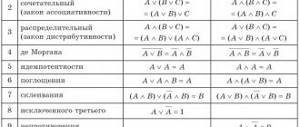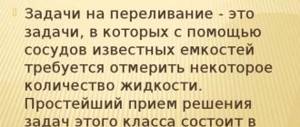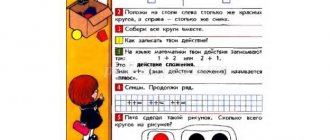Finding a fraction from a number
We have already said that a fraction is a part of something. This part can be anything. For example, from a pizza this is half a pizza:
But the use of fractions doesn't end with one pizza. For example, you can find out how much is ten centimeters:
As you may have guessed, ten centimeters equals five centimeters. After all, this is the simplest fraction that means half of something. We had ten centimeters. We divided these ten centimeters in half and got five centimeters.
Let's try to find out how much one hour is. Remember that an hour is 60 minutes. We need to find (half) of 60 minutes. It's not hard to guess that half of 60 minutes is 30 minutes. This means that one hour is 30 minutes or half an hour.
Let's try to find from one hundredweight. A centner is 100 kg. You need to find (half) of 100 kg. It is not difficult to guess that half of 100 kg is 50 kg. This means that one hundredweight equals 50 kg.
Since we are doing mathematics, in most cases we will be dealing with numbers. For example, let's find from the number 12.
So, you need to find half of the number 12. It is not difficult to guess that half of the number 12 is the number 6. This means that the number 12 is the number 6.
To make it easier to find a fraction from a number, you can use the following rule:
To find a fraction of a number, you need to divide this number by the denominator of the fraction, and multiply the resulting result by the numerator of the fraction.
Let's try to trace the entire process of how this rule works. For example, let's take ten centimeters:
Let it be required to find from these ten centimeters. Let's read the first part of the rule:
To find a fraction of a number, you need to divide that number by the denominator of the fraction
So, we divide ten centimeters by the denominator of the fraction. The denominator of this fraction is equal to the number 2. Therefore, we divide ten centimeters by 2
10 cm: 2 = 5 cm
Read the second part of the rule:
and multiply the result by the numerator of the fraction
So, we multiply five centimeters by the numerator of the fraction. The numerator of the fraction in this case is one. Therefore, we multiply five centimeters by one:
5 cm × 1 = 5 cm
We found from ten centimeters. We see that ten centimeters equals five centimeters:
Why, after dividing a number by the denominator of a fraction, do you have to multiply the result by the numerator of the fraction? The fact is that the denominator of a fraction shows how many parts something is divided into, and the numerator shows how many parts were taken.
In our example, ten centimeters were divided into two parts (in half), and one part was taken from these parts. By multiplying one part by the numerator of a fraction, we thereby indicate how many parts we take from something. That is, by multiplying five centimeters by the numerator of the fraction, we thereby indicated that we are taking one part from two.
Example 2. Find from 10 cm.
Let's apply the rule for finding a fraction from a number:
To find a fraction of a number, you need to divide this number by the denominator of the fraction, and multiply the resulting result by the numerator of the fraction.
First, divide 10 centimeters by the denominator of the fraction
10 cm : 5 = 2 cm
We got two centimeters. This result must be multiplied by the numerator of the fraction
2 cm × 2 = 4 cm
We found from ten centimeters. We see that ten centimeters equals four centimeters.
The entire solution process can be seen in the following figure:
First, ten centimeters were divided into five equal parts. Then two parts were taken from these five parts:
Example 3. Find from the number 56.
To find the number 56, you need to divide this number by the denominator of the fraction, and multiply the resulting result by the numerator of the fraction.
So, first we divide the number 56 by the denominator of the fraction
56 : 8 = 7
Now we multiply the result by the numerator of the fraction
7 × 3 = 21
We received the answer 21. So the number 56 is 21.
Example 4. Find from one hour.
One hour is 60 minutes. The task can be understood as finding 60 minutes.
First, divide 60 minutes by the denominator of the fraction
60 min: 4 = 15 min
Now multiply the resulting 15 minutes by the numerator of the fraction
15 min × 2 = 30 min
We received a response of 30 minutes. This means that one hour equals thirty minutes or half an hour.
Example 5. Find from one meter.
One meter is one hundred centimeters. First, divide 100 cm by the denominator of the fraction
100 cm: 5 = 20 cm
Now multiply the resulting 20 cm by the numerator of the fraction
20 cm × 4 = 80 cm
We received the answer 80 cm. This means that 80 cm are equal to one meter.
Finding a whole number from a fraction
Knowing the part of the number and how much of the whole number it is, you can find the original integer. This is the reverse problem to the one we considered in the previous topic. There we looked for a fraction of a number, dividing this number by the denominator of the fraction, and multiplying the resulting result by the numerator of the fraction.
And now, on the contrary, knowing the fraction and how much it is from the number, find the original integer.
For example, if the length of the ruler is six centimeters and we are told to find the length of the entire ruler, then we must understand that we are required to find the original integer (the length of the entire ruler) using a fraction. Let's solve this problem.
You need to find the length of the entire ruler using a fraction. It is known that the length of the entire ruler is 6 cm.
We already know how these 6 cm were obtained. There was some length, it was divided into five parts, since the denominator of the fraction is the number 5. Then two parts were taken from five parts, since the numerator of the fraction is the number 2.
To find out the length of the entire ruler, you first need to know the length of one part. How to find out? Let's try to guess by carefully studying the following figure:
If two parts of the length of the ruler are 6 cm, then it is easy to guess that one part is 3 cm. And to get these 3 cm, you need to divide 6 by 2
6 cm: 2 = 3 cm
So, we have found the length of one part. One part out of five or the length of the ruler is 3 cm. If there are only five parts, then to find the length of the ruler, you need to take three centimeters five times. In other words, multiply 3 cm by the number 5
3 cm × 5 = 15
We found the length of the ruler. It is 15 centimeters. This can be seen in the following figure.
It can be seen that five parts out of five or equal fifteen centimeters.
To make it easier to find a number by its fraction, you can use the following rule:
To find a number by its fraction, you need to divide the known number by the numerator of the fraction, and multiply the resulting result by the denominator of the fraction.
Example 2 . The number 20 is from the whole number. Find this number.
The denominator of a fraction shows that the number we need to find is divided into five parts. If this number is the number 20, then to find the whole number, you first need to find (one part of five) of the whole number. To do this, 20 must be divided by the numerator of the fraction
20 : 4 = 5
We found from the entire number. This part is equal to 5. To find the whole number, you need to multiply the resulting result 5 by the denominator of the fraction
5 × 5 = 25
We found from the entire number. In other words, we found the entire number that we were required to find. This number is 25.
Example 3. Ten minutes is the cooking time for porridge. Find the total cooking time for the porridge.
The denominator of the fraction shows that the total cooking time of the porridge is divided into three parts. If the cooking time for porridge is ten minutes, then to find the total cooking time, you must first find the cooking time. To do this, 10 must be divided by the numerator of the fraction
10 min: 2 = 5 min
We found time to prepare the porridge. The cooking time for the porridge is five minutes. To find the total cooking time, you need to multiply 5 minutes by the denominator of the fraction
5 min × 3 = 15 min
We found the cooking time for the porridge, that is, we found the total cooking time. It is 15 minutes.
Example 4. The mass of a bag of cement is 30 kg. Find the total mass of the bag.
The denominator of the fraction shows that the total mass of the bag is divided into four parts. If the mass of the bag is 30 kg, then in order to find the total mass of the bag you must first find the mass of the bag. To do this, 30 must be divided by the numerator of the fraction.
30kg : 2 = 15kg
We found the masses of the bag. The weight of the bag is 15 kg. Now, to find the total mass of the bag, you need to multiply 15 kg by the denominator of the fraction
15kg × 4 = 60kg
We found the masses of the bag. In other words, we found the total mass of the bag. The total weight of a bag of cement is 60 kg.
Plan – summary of a mathematics lesson in 4th grade on the topic “Finding several parts of a whole”
− Now, we will watch the cartoon “We Divided an Orange”, in which animals will face the problem of dividing an orange. We look at the screen.
Slide
4 (cartoon “We divided the orange”)
− How did the animals divide the orange? (The whole orange was divided into slices)
- Is there enough for everyone? (No)
− What should have been done? (Count how many animals there are and divide equally).
-What is the wolf’s mistake? (He decided to take the whole orange for himself.)
- Guys, can we do this? (No, you need to be able to share).
-Now we will learn to divide the whole into parts
− Take the strip that is on your desk. Measure its length (20 cm)
− Fold it in half and in half again. How many identical shares did you get? (4.)
- What do you think is the length of one beat? (5 cm)
−How did you determine? (20: 4 = 5 (cm))
- Yes, we already know how to determine the value of one share.
− Take a ruler and measure the length of the lobe.
− Write on each lobe its length (5 cm)
−What is the length of two such lobes? (10 cm)
− How did you know? ( The number 5 is repeated 2 times: 5∙2 = 10(cm))
− What is the length of three such lobes? (15 cm)
−How did you know? ( The number 5 is repeated 3 times:
5 ∙
3 = 15 (cm))
− Set aside.
Slide 5
(whole square)
− Look at the slide
S — ?
6cm
− Remember how to find the area of a square? (To find the area of a square, you need to multiply its side by itself)
−What is the area of this square? ( 6 6 = 36(cm2 ) )
-Let's check.
Slide 6
(square with shares)
- Now we need to find the area of the shaded figure
− Can we do this? (No)
S — ?
- Why? (We don't know how to find the area of a triangle
)
−I wonder how you can find the area of a shaded figure?
− Formulate the topic of the lesson. (Finding several parts of a whole.)
Slide 7
(Lesson topic: “Finding several parts of a whole”)
− Lesson topic: “Finding several parts of a whole” (the topic is also posted on the board)
− Knowing the topic, set the goals of the lesson (learn to solve problems to find several parts of a whole, remember how to find a fraction of a number, develop computational skills)
Slide 8
(Lesson objectives)
− The objectives of our lesson are to learn to solve problems involving finding several parts of a whole; remember how to find the fraction of a number; develop computing skills.
IV . Work on the topic of the lesson
Working with a cake model
- And if I say that a family also consists of shares, will you agree with me? (Yes. A family is a single whole, and each family member is part of it)
- Do you think family members are equal in importance or not? (children's answers)
− In a family, each member is equally valuable, important and dear, i.e. all family members are equal. And if this rule is applied to shares, what can we say about them? ( all parts of one whole are equal)
Dividing a smaller number by a larger number
In life, situations often arise when you need to divide a smaller number by a larger one. For example, let's imagine a situation. There are three friends:
And you need to divide two apples equally between them. How to do it? There are three friends, but only two apples. We find ourselves in a situation in which we need to divide a smaller number by a larger one (two apples for three).
For such cases, the following rule is provided:
When a smaller number is divided by a larger number, the result is a fraction with the dividend in the numerator and the divisor in the denominator.
Let's apply this rule. It says that when a smaller number is divided by a larger number, the result is a fraction whose numerator contains the dividend and the denominator contains the divisor. What we divide is two apples. We write the number 2 in the numerator:
And our divisor is three friends (remember that the divisor shows how many parts the dividend must be divided into). We write three in the denominator of our fraction:
It's funny, but the fraction is the answer to our problem. Each friend will get an apple. Why did it happen?
To divide two apples among three, you need to cut each apple into three parts with a knife and scatter these pieces equally among three friends:
As you can see in the picture, each apple was divided into three parts and scattered equally among three friends. Each friend got an apple (two pieces out of three).
What part is one number of another?
Sometimes there is a need to find out what part the first number is from the second. For such cases, the following rule is provided:
To find out what part the first number is of the second, you need to divide the first number by the second.
For example, an apple was divided into five identical slices. What part of an apple is made up of two slices?
To answer this question, you need to divide the first number by the second. The first number is 2, the second is 5. The result is a fraction.
This means that two out of five slices are two-fifths. This can be seen in the following figure:
So, two out of five apple slices are two-fifths.
The question arises, how do you find out which number is the first and which is the second? To do this, you need to look at the question posed in the problem. The number indicated in the problem question will be the first number. For example, in the previous problem the question was posed like this:
“What part of an apple are two of these slices?”
If you look closely at the question, you will find that the number 2 is indicated in it. This became the first number.
Sometimes two numbers appear in a question at once. For example: what part is the number 2 of the number 10?
In this case, the first number will be the one that appears earlier in the question. In this case, the first number is 2, and the second is 10. Divide 2 by 10, we get the fraction. This means that the number 2 of the number 10 is (two tenths).
A fraction means that the number 10 is divided into ten parts, and from these ten parts two parts are taken.
Also, this fraction can be reduced by 2. After reducing the fraction by 2, we get the fraction .
A fraction can also serve as an answer to the problem. It will mean that the number 10 is divided into five parts, and one part is taken from these five parts.
Thus, the number 2 is (one fifth) of the number 10.
Example 3. What part is the number 5 of the number 15?
Divide the first number by the second. The first number is 5, and the second is 15. Divide 5 by 15, we get the fraction. This fraction can be reduced by 5
We got a neat fraction. So the answer will look like this:
The number 5 is (one third) of the number 15.
You can even check this. To do this, you need to find the number 15. If we did everything correctly, we should get the number 5.
So, let’s find from the number 15. We already know how to find a fraction from a number
15 : 3 = 5
5 × 1 = 5
We received the answer 5. This means the problem was solved correctly.
Example 4. What part of 3 cm is 12 cm?
Divide the first number by the second. The first number is 3, and the second is 12. We get the fraction. This fraction can be reduced by 3
We received an answer. So 3 cm is (one fourth) of 12 cm.
Let's check if we solved this problem correctly. To do this, we will find from 12 cm. If we did everything correctly, we should get 3 cm.
Divide 12 by the denominator of the fraction
12 cm: 4 = 3 cm
Multiply the resulting 3 cm by the numerator of the fraction
3 cm × 1 = 3 cm
We received an answer of 3 cm. This means the problem was solved correctly.
How to find 100% of a known percentage value
Let's say we have data on returns in rubles and as a percentage of sales. Knowing this data, we need to find the amount of sales for each employee, that is, 100%.
We compose and solve the proportion. We multiply the values diagonally from x and divide by the opposite number diagonally from x:
We write the formula in cell D2 and extend it down to other employees:
Let's say we have sales data for 2014 and 2020. You need to find out the percentage change in sales.
To find out how much sales have changed, you need to subtract the data for 2020 from the data for 2014.
25686-35682=-9996
We find that sales decreased (minus sign) by 9996 rubles. Now you need to calculate how much it is as a percentage. Our starting point is 2014. It is with this year that we compare how much sales have changed, so 2014 is 100%
We make up a proportion and solve it: multiply the values diagonally from x and divide by the opposite number diagonally from x
x=-9996*100%/35682=-28.02%
Thus, the amount of sales in 2020 decreased (minus sign) by 28.02% compared to 2014.
A share is a certain number of equal parts into which the whole is divided. Since in most areas of activity of our civilization today the decimal system of calculation dominates, it is most often customary to divide the whole into the number of parts derived from ten. The most commonly used is one hundredth - a percentage.
Posting sponsor P&G Articles on the topic “How to find a share in a percentage” How to convert grams to percentages How to find the percentage of the difference between numbers How to find what percentage a number is
Instructions
If the value of a fraction is expressed in the format of an ordinary fraction, then this means that the whole, undivided value contains the number of fractions that is indicated in the denominator of the fraction. Calculate exactly how many percent are in each fraction by dividing one hundred percent (the whole number) by the number in the denominator of the fraction (the total number of fractions). Multiply the resulting value by the number in the numerator of the common fraction - this will be the desired percentage value. For example, if a share is expressed as a fraction 4/15, then there are 15 shares in total and each of them accounts for 100% / 15? 6.67%, and the desired value corresponds to 4 * 6.67%? 26.67%. Sometimes the fraction is expressed as a decimal fraction. Most often this number is less than one, but there are exceptions when the share is more than one hundred percent. In any case, the total whole is taken to be equal to one, and to calculate the value of the fraction as a percentage, it is enough to increase the decimal fraction by a hundred times. For example, if it is expressed as 0.42, then the corresponding percentage value will be equal to 0.42*100=42%. The share can also be given in absolute units - in rubles, square meters, kilograms, etc. In this case, to calculate percentages, you also need to know the number expressed in the same units, corresponding to one hundred percent. Divide this number by a hundred to find out how many absolute units there are for each percentage, and divide the value converted to percentage by the result obtained. For example, if the share is equal to 40 square meters of housing with a total area of 120 m², then each percentage corresponds to 120/100 = 1.2 m². This means that the forty-meter percentage will be equal to 40/1.2? 33.3%. How simple
Other news on the topic:
A percentage of a number is a hundredth of that number, denoted 1%. One hundred percent (100%) is equal to the number itself, and 10% of a number is equal to a tenth of that number. Subtracting a percentage means reducing a number by some fraction. You will need a calculator, a piece of paper, a pen, and mental arithmetic skills. Sponsor
A percentage is one hundredth of some original value. This is a proportion, that is, a relative indicator that has no dimension (rubles, pieces, liters, etc.). In addition to simple operations of finding percentages, sometimes it is necessary to perform more complex ones - for example, dividing percentages by
A number that consists of one or many parts of one whole is usually called a fraction in mathematics and related sciences. The parts of a unit are called shares. The total number of parts in a unit is the denominator of the fraction, and the number of parts taken is its numerator. You will need - a sheet of paper; - pen; —
The word "percentage" means a hundredth of a number, and a fraction is, accordingly, a part of something. Therefore, to determine the percentage of a number, it is necessary to find the fraction of it, given that the original number is a whole hundred. To perform this action you need to be able to solve proportions. Sponsor
A percentage is a relative unit of measurement that expresses the value of a certain fraction of a total whole compared to the number 100. A value written in fraction format also shows the ratio of the fraction (numerator) to the whole (denominator). This allows you to convert any number into a percentage, making
Sometimes when solving problems it becomes necessary to express a fraction as a percentage. You can convert a decimal fraction, an ordinary fraction, a regular fraction, or an irregular fraction into a percentage. Let's look at how to do this. Sponsored by P&G Articles on the topic “How to express a number” How to find a percentage of a number How
In general, a percentage is a fraction equal to one hundredth of a unit. However, more often it is used as a relative unit of measurement for the amount of something, and then one percent takes on a variety of numerical values. A quantitative measure of a certain fraction of
In this lesson, you will see how to quickly calculate percentages using Excel, get acquainted with the basic formula for calculating percentages, and learn a few tricks that will make your work with percentages easier. For example, the formula for calculating percentage growth, calculating the percentage of the total amount and something else.
Knowing how to work with percentages can be useful in a variety of areas of life. This will help you estimate the amount of tips in a restaurant, calculate commissions, calculate the profitability of any enterprise and the degree of your personal interest in this enterprise. Tell me honestly, will you be happy if they give you a promotional code for a 25% discount to buy a new plasma? Sounds tempting, right?! Can you calculate how much you will actually have to pay?
In this tutorial, we'll show you several techniques that will help you easily calculate percentages using Excel, as well as introduce you to the basic formulas that are used to work with percentages. You'll learn some tricks and hone your skills by working out solutions to practical problems using percentages.




